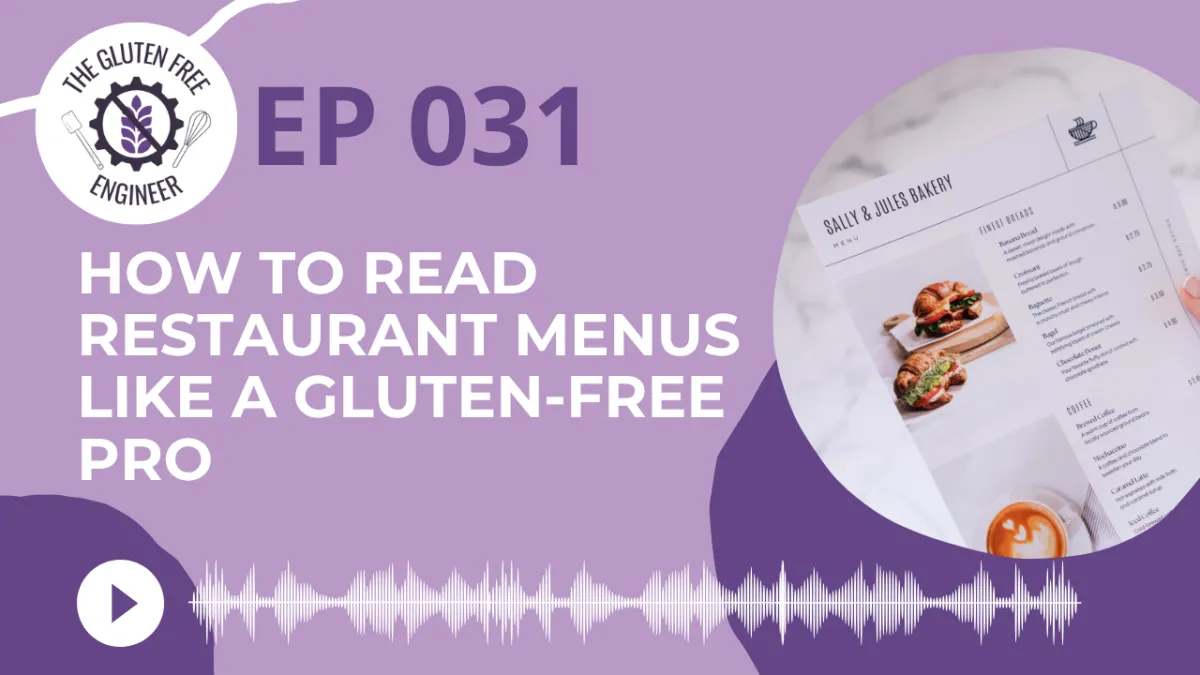
#31: How to Read Restaurant Menus Like a Gluten-Free Pro
Ever stared at a restaurant menu and thought... ‘Okay, is anything actually safe here?’
Whether you’re newly gluten-free or a seasoned label-reader, eating out can still be stressful. In today’s episode, I’ll walk you through exactly how I read menus like a gluten-free detective—so you can eat out with more confidence and less guesswork.
I’ll even share a simple sentence I use with servers that instantly changes the tone of the conversation. And don’t miss my bonus tip at the end—something I always do before we even leave the house that has saved us so many times.
Let's Recap: How to Read Menus Like a Gluten-Free Detective
Navigating restaurant dining with celiac disease or gluten intolerance can feel like walking through a minefield blindfolded. As someone diagnosed with celiac disease in 2011, I've spent years developing strategies to decode restaurant menus and eat out safely. Today, I want to share my proven system for reading restaurant menus like a gluten-free detective—so you can dine out with confidence rather than anxiety.
Re-frame Your Mindset: You're Not Being "Picky"
The first step in my approach is acknowledging that you're not being "picky"—you're protecting your health. This mental reframing is crucial because many of us feel like burdens when dining out. Remember, this is a medical necessity, not a preference. With that mindset established, begin by scanning menu headings for sections labeled "gluten-free," "healthy options," or "allergy-friendly." These sections indicate that the restaurant has at least some awareness of dietary restrictions.
However, I always recommend asking if they have a separate gluten-free menu, as approximately 50% of restaurants (especially in larger cities) now offer this option. One important distinction: “gluten-sensitive” does not necessarily mean safe for those with celiac disease—so always clarify this point.
Learn the Language of Hidden Gluten
Understanding the language of hidden gluten is your next critical skill. When reading menu descriptions, be wary of red-flag terms like:
Breaded
Crispy
Battered
Roux
Soy sauce
House sauce
Gravies
These typically indicate gluten presence.
Many people don’t realize that gluten can hide in unexpected places—marinades, salad dressings, seasoning blends, and even scrambled eggs. (Yes, some restaurants add flour or pancake mix to eggs to make them fluffier!) A seemingly safe grilled chicken dish might be pre-marinated in soy sauce, which often contains wheat. This detective work requires vigilance about these hidden sources of gluten.
Don’t Rely Solely on Menu Symbols
Menu symbols can be helpful guides—but they require verification. Look for GF markers or wheat symbols with lines through them, but don’t rely solely on those. Always check for disclaimers that mention things like “not safe for celiac disease.”
Sometimes these warnings are just legal precautions. For example, a restaurant in Columbus called Preston’s has incredible gluten-free chicken strips and burgers, even though their menu includes a general gluten disclaimer. They prep gluten-free items in a separate section, making them reasonably safe for most celiac diners. When in doubt, call ahead or ask about their cross-contamination protocols.
Communicate Clearly and Confidently
Communication with restaurant staff is perhaps the most crucial aspect of dining out safely. I’ve developed a go-to phrase that has transformed my experiences:
“Hi, I have celiac disease, so I need to eat 100% gluten-free with no cross contact. Can you help me figure out what’s safe, or should I speak with a chef or manager?”
This approach clearly states your needs while offering staff a path to get additional help if needed.
At familiar spots, I sometimes simplify it to:
“I have a gluten allergy. What would be safest for me?”
Why? Some staff better understand the word “allergy” than “celiac disease,” even though we know they're not the same.
Know Which Cuisines Are Typically Safer
Certain cuisines tend to be more gluten-free friendly. Here are some general trends:
✅ Safer Options:
Mexican (corn-based dishes)
Thai (often avoids soy sauce)
Indian (though check sauces and breads)
Steakhouses (verify seasonings and fryer use)
⚠️ Use Caution:
Asian fusion (heavy on soy sauce)
Italian (only if they have dedicated GF prep areas)
Pub food (cross-contaminated fryers are common)
In Italian restaurants especially, confirm that gluten-free pasta is cooked in separate water. Some places still make the mistake of reusing pasta water—an easy cross-contamination risk.
Trust Your Gut—Literally and Figuratively
My final piece of advice is simple but powerful: trust your gut. If a server seems confused or dismissive, it’s not worth the risk. You are never “too much” for prioritizing your health. I’ve walked out of restaurants hungry rather than gamble with getting sick—and I’ve never regretted it.
Bonus tip: Always check the menu online before heading out. Screenshot safe-looking items in case you lose signal once you're there. It’s a small step that can make a big difference.
Dining out with celiac doesn’t have to feel like a high-stakes game. With preparation, awareness, and a confident mindset, you can enjoy a safe, delicious meal—without the stress.
